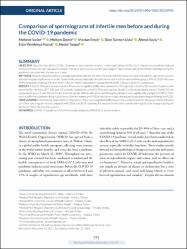Comparison of spermiograms of infertile men before and during the COVID-19 pandemic

Göster/
Erişim
info:eu-repo/semantics/openAccessTarih
2022Yazar
Sarıer, MehmetDemir, Meltem
Emek, Mestan
Usta, Sibel Sürmen
Soylu, Ahmet
Konuk, Elçin Yenidünya
Üst veri
Tüm öğe kaydını gösterKünye
Sarier, M., Demir, M., Emek, M., Usta, S. S., Soylu, A., Konuk, E. Y., & Turgut, H. (2022). Comparison of spermiograms of infertile men before and during the COVID-19 pandemic. Revista Da Associação Médica Brasileira, 68(2), pp.191–195. https://doi.org/10.1590/1806-9282.20210935 Özet
OBJECTIVE: Since the start of the COVID-19 pandemic, there has been interest in the impact of both SARS-CoV-2 infection and pandemic-induced social restrictions on male reproductive health. This study aimed to evaluate the spermiogram values of men who presented for infertility during the pandemic compared with the previous 2 years. METHODS: Patients who presented to a urology outpatient clinic for the first time due to infertility were included. The patients' age, semen volume, and spermiogram results were recorded. Based on the presentation date, the patients were divided into prepandemic group 1 (March 2018-February 2019), prepandemic group 2 (March 2019-February 2020), and pandemic group (March 2020-February 2021) for comparison. RESULTS: A total of 594 patients were included. There was no significant difference between the three groups in terms of the number of patients who presented for infertility (207, 190, and 197 patients, respectively; p=0.691). The mean age was 36.6 +/- 7.2 in the prepandemic group 1, 35.5 +/- 7.1 in the prepandemic group 2, and 33.1 +/- 6.3 in the pandemic group. Patients who presented during the pandemic were significantly younger (p<0.001). There were no differences between the groups in terms of semen volume (p=0.910) or rates of normospermia and pathological spermiogram findings (p=0.222). CONCLUSIONS: In the first year of the COVID-19 pandemic, there was no significant difference in the number of patients who presented for infertility or in their spermiogram results compared with 2018 and 2019. However, it is noteworthy that the patients were significantly younger during the pandemic than in the previous 2 years.
















